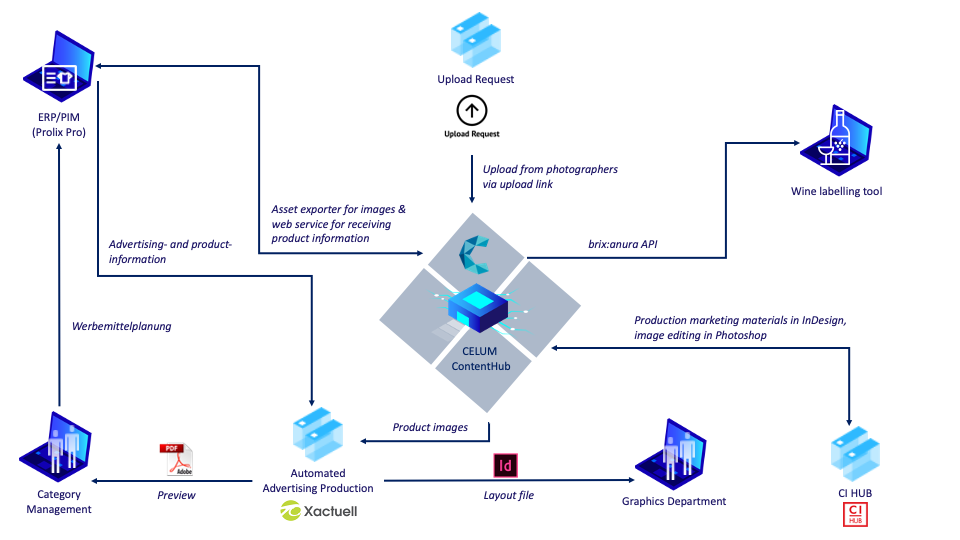Migration project Transgourmet Prodega
by Veronika Altenbach
We at brix are proud to have contributed significantly to the efficient production of advertising materials in the areas of DAM (Digital Asset Management) and DDP (Dynamic Database Publishing) for the past 13 years.
Back in 2008, the first Prodega-Express catalog (at that time still using QuarkXPress) was produced automatically. With the increasing importance of the image database, we had the opportunity to introduce CELUM in 2013 and replace the existing DAM system. Now the next step was just around the corner.
From CELUM 4 directly to CELUM 6 – without detours
Planning a successful migration is still not an easy undertaking, especially because such projects are often involve various dependencies. ERP connections, web store systems and PIM solutions play a key role here.
Transgourmet/Prodega also has a complex system landscape in which the interaction of the various IT solutions is a key factor in the company's success.
With the decision to update the internal ERP/PIM system and the migration to CELUM 6, the company reached another milestone on the path of its digital transformation.
The heart of the system landscape is the CELUM ContentHub – in other words, the data hub for around 100,000 assets in the form of product and marketing images. To use the approximately 90,000 existing product assets in the ERP/PIM, as well as in the web shops and for the production of advertising material, they are exported in a variety of formats optimized for each channel.
Considering the constantly growing number of uploaded assets from among 50 CELUM power users and external photographers for editing and the purpose of orchestration in the ContentHub, you quickly recognize the need for efficient interaction between the IT systems in use. With the migration from CELUM 4 to CELUM 6, this goal was achieved while productivity was further expanded.
By using the latest version of CELUM ContentHub and its intuitive user interface, Transgourmet/Prodega could create significant value. In addition, our extensions help to optimize work processes and further increase efficiency.
The interaction of DAM and PIM
By using a web service, the product structure from the ERP/PIM is synced to the ContentHub in CELUM 6. When uploading new product assets, the Metadata Mapper ensures that the correct asset type is set and the asset is assigned to the correct structure node, based on the article number. Relevant product information is then transferred to the asset via Carbon Copy. In addition, all relevant changes in the ERP/PIM are regularly updated on the structure using a sync task. This means that all product assets are always tagged with up-to-date product information.
Automated production of advertising materials
Transgourmet/Prodega uses the Xactuell publishing tool for automated advertising production (print and online). Product and placement information from the ERP/PIM and product images from the CELUM ContentHub are automatically transferred via Xactuell to the layout program (Adobe InDesign) according to plan made by the category manager – for uninterrupted production of advertising materials (approx. 4,000 pages per year + language change in French and Italian).
Extensions for increased efficiency and quality assurance
- Upload Request: External partners can use an upload link to import images directly into the CELUM ContentHub for further processing without logging in.
- Metadata Mapper: Automatic transfer of IPTC data from assets to metadata and automated assignment of product images to the product structure.
- Asset Exporter: Delta delivery of various image derivatives for the various peripheral systems (ERP, PIM, Web shop, Xactuell, BSI Cloud).
- Asset Validation: Validation and marking of assets that do not meet the defined quality requirements. Early recognition massively shortens the time needed to acquire new imagery.
- Carbon Copy: Transfers the product information stored on the structure node to the metadata of the asset as soon as it is assigned to the product structure.
- brix:anura: Use of the brix:anura API to connect the CELUM ContentHub to an internally developed wine label tool.
- CI HUB: Easy image editing process for assets that are already stored in CELUM ContentHub. This allows assets to be easily and quickly placed in Adobe Creative Cloud and Microsoft Office applications without time-consuming jumping back and forth between different tools.
With the go-live date of «spring 2021» in mind, the time in 2020 was used to finalize the concept and to make various preparations. Among other things, the ERP/PIM system «Prolix Pro» was updated, a CELUM test environment was set up, and a new network zone for the productive DAM system was established.
On the CELUM test environment, the entire migration process with all relevant system connections and dependencies could be tested in the beginning of 2021. In addition, all assets from CELUM 4 were migrated to the CELUM 6 test environment and exported for the surrounding systems in advance, so that only the delta had to be added for the go-live. This made it possible to complete the live migration in March 2021 in just one and a half weeks.
After the successful migration, Transgourmet/Prodega would like to realize further expansion projects. Currently, planned are:
- Workflows for PDF review processes of publications
- Simple asset release process to ensure image quality and image processing



